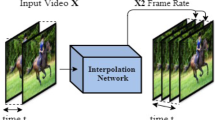Abstract
Today, everyone is demanding high-quality video services along with large bandwidth. Due to this demand, a ruthless burden is felt across the network architecture. Thus, a recently developed video codec H.265, also called high-efficiency video coding (HEVC), offers high coding efficiency than its predecessor H.264 Advanced Video Coding. Although H.265 or HEVC offers a greatly improved compression ratio, it is done at the expense of a high increase in computational complexity and time complexity to process the video compression. This disadvantage of HEVC makes it less suitable for real-time video sequences that may contain varying motion activities. Therefore, it is insufficient to use conventional motion estimation techniques that consume 80–90% of the total computational power. The research work presented in this paper deals with these two-short coming of H.265 HEVC. In this paper, first, an improved motion estimation technique is presented, which yields higher compression efficiency, computational complexities and better video quality, especially for low and medium video resolution applications such as handheld devices based videotelephony. Experimental results using improved motion estimation technique based on Quadtree decomposition and A* prune algorithm optimization reveals that total bits for different multi constraints shortest path get reduced while retaining the quality of video in reconstruction part. Besides, it can also be used in various multimedia applications with restricted computational resources.













































Similar content being viewed by others
References
Art P (2013) Method of determining binary code words for transform coefficients, no 19
Barquero D (2013) Next generation mobile broadcasting. CRC Press
Bross B, Han WJ, Sullivan GJ, Ohm JR, Wiegand T (2012) High efficiency video coding (HEVC) text specification draft 9. In: document JCTVC-K1003, ITUT/ISO/IEC Joint Collaborative Team on Video Coding (JCT-VC)
Budagavi M, Sze V (2014) Design and implementation of next generation video coding systems (H.265/HEVC Tutorial). IEEE international symposium on circuits and systems (ISCAS), Melbourne, Australia
Choudhury HA, Sinha N, Saikia M (2020) Nature inspired algorithms (NIA) for efficient video compression—a brief study. Int J Eng Sci Technol 23(3):507–526
Cisco Systems (2016) Cisco Visual Networking Index—Forecast and Methodology
da Silva TL, Agostini LV, da Silva Cruz LA (2012) Fast HEVC intra prediction mode decision based on EDGE direction information. In: Proceedings of the 20th European Signal Processing Conference (EUSIPCO), Bucharest, Romania, pp 1214–1218
De Neve H, Van Mieghem P (1998) A multiple quality of service routing algorithm for PNNI. In: Proceedings 1998 IEEE ATM Workshop, May 26–29, Fairfax, VA, USA, pp.324–328
Gang L, Ramakrishnan KG (2001) A*Prune: an algorithm for finding K-shortest paths subject to multiple constraints. IEEE INFOCOM, pp 743–749
Huang CK, Wu LC, Huang HT, Sheng TH, Youn LL (2011) A low-power highperformance H.264/AVC intra-frame encoder for 1080p HD Video. IEEE Trans Very Large Scale Integr Syst 19(6):925–938
Iec SO, Sc JTC, Kim CI, Mccann KD, Sugimoto K, Bross B, Han W, Sullivan GJ (2013) International organization for standardization organisation international de normalisation iso/iecjtc1/sc29/wg11 coding of moving pictures and audio description
Kim I-K, Min J, Lee T, Han W-J, Park J (2012) Block partitioning structure in the HEVC standard. IEEE Trans Circuits Syst Video Technol 22(12):1697–1706
Lian XTLY (2011) Entropy Coders of the H.264/AVC Standard
Norkin GB, Fuldseth A, Narroschke M, Ikeda M, Andersson K (2012) HEVC deblocking filter. IEEE Trans Circuits Syst Video Technol 22:1746–1754
Richardson I (2013) HEVC: an introduction to high efficiency video coding compression HEVC
Shahid Z, Puech W (2013) Investigating the structure preserving encryption of high efficiency video coding (HEVC), pp 86560N
Shifa A, Naveed Asghar M, Ahmed A (2020) Fuzzy-logic threat classification for multi-level selective encryption over real-time video streams. J Ambient Intell Hum Comput 11:5369–5397 https://doi.org/10.1007/s12652-020-01895-2
Sullivan GJ (2012) Overview of the high efficiency video coding (HEVC) Standard. IEEE Trans Circuits Syst Video Technol 22:1649–1668
Sullivan GJ, Bjøntegaard G, Luthra A, Wiegand T (2003) Overview of the H.264/AVC video coding standard. IEEE Trans Circuits Syst Video Technol 13(7):560–576
Sze V, Budagavi M, Sullivan GJ (2014) High efficiency video coding (HEVC). In: Integrated circuit and systems, algorithms and architectures. Springer, pp 1–375
The H.264 advanced video compression standard (2010) Wiley
Vanne J, Viitanen M, Hämäläinen TD, Hallapuro A (2012) Comparative ratedistortion-complexity analysis of HEVC and AVC video codecs. IEEE Trans Circuits Syst Video Technol 22(12):1885–1898
Author information
Authors and Affiliations
Corresponding authors
Additional information
Publisher's Note
Springer Nature remains neutral with regard to jurisdictional claims in published maps and institutional affiliations.
Rights and permissions
About this article
Cite this article
Kumar, R., Kumar, K., Mahajan, S. et al. Study and implementation of K-multiple constraint shortest path for H.265 HEVC for optimal video compression. J Ambient Intell Human Comput 14, 6149–6164 (2023). https://doi.org/10.1007/s12652-021-03031-0
Received:
Accepted:
Published:
Issue Date:
DOI: https://doi.org/10.1007/s12652-021-03031-0




